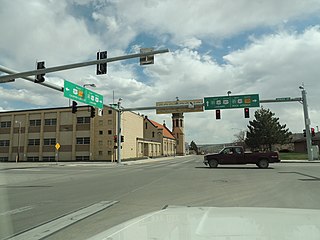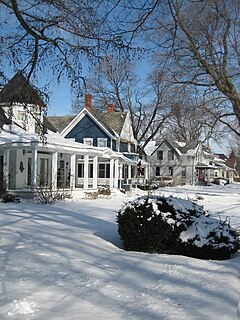
The Sycamore Historic District is a meandering area encompassing 99 acres (400,000 m2) of the land in and around the downtown of the DeKalb County, Illinois, county seat, Sycamore. The area includes historic buildings and a number of historical and Victorian homes. Some significant structures are among those located within the Historic District including the DeKalb County Courthouse and the Sycamore Public Library. The district has been listed on the National Register of Historic Places since May 2, 1978.

The Downtown Santa Ana Historic Districts is a combination of local historic districts that have been listed as one entry in the National Register of Historic Places since 1984. It is a 24.5-acre (9.9 ha) area. Also known as the Historic Downtown District in Santa Ana, it is roughly bounded by Ross to French streets and First to Civic Center streets. The district is characterized by a number of buildings in the Art Deco style as well as two old movie houses. Orange County's first Courthouse, now a museum, is also located on Civic Center and Broadway streets. The Dr. Willella Howe-Waffle House and Medical Museum is also in this area and it is now home to the Santa Ana Historical Preservation Society. The County's first theater, Walker's Theater, was built in 1909 on Main & Second streets adjacent to the old City Hall. Today, the Main Street Studio Lofts now stand where the county's first movie house used to be.

The Rochester Downtown Historic District is a historic district on the National Register of Historic Places (NRHP) in Rochester, Indiana, United States. It was placed on the Register on June 24, 2008. The majority of buildings in the area are masonry and Italianate while structures outside the district are largely residential frame built structures.
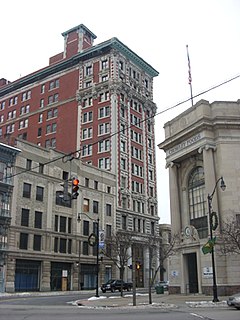
Court Street Historic District is a national historic district located at Binghamton in Broome County, New York. The district includes 87 contributing buildings and encompasses the historic downtown core of downtown Binghamton. The majority of the contributing structures are commercial buildings built between about 1840 and 1939. Ten and twelve story office buildings built in the 20th century are prominent features of the district. Located within the boundaries of the district are the separately listed Broome County Courthouse and Binghamton City Hall.

The Downtown Adrian Commercial Historic District is a historic district comprising the downtown area of Adrian, Michigan. It was designated as a Michigan Historic Site and added to the National Register of Historic Places on April 17, 1986. The district is roughly bounded on the north by Toledo Street, on the east by North Broad Street, on the south by East Church Street, and on the west by North Winter Street (M-52), West Maumee Street, and the River Raisin. Most of the district is enclosed by the US-223 Business Route, although the two are not conterminous.

The Hudson Downtown Historic District is a historic district comprising the downtown area of the city of Hudson in westernmost Lenawee County, Michigan. It was designated as a Michigan Historic Site on January 21, 1974. It was later added to the National Register of Historic Places on December 24, 1974.

The Downtown Rock Springs Historic District is a 15.97-acre (6.46 ha) historic district that was listed on the National Register of Historic Places in 1994. It is roughly bounded by K, 4th, C, 2nd, A, and 5th Streets in downtown Rock Springs, Wyoming.
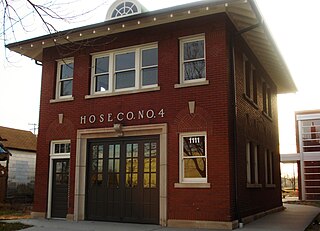
The Bohemian Commercial Historic District, also known as New Bohemia, is located in Cedar Rapids, Iowa, United States. It was listed on the National Register of Historic Places in 2002. At the time of its nomination it consisted of 75 resources, which included 48 contributing buildings, and 27 non-contributing buildings. Bohemian immigrants began settling in Cedar Rapids in the 1850s, and increasingly after the American Civil War in the 1860s and the Prussian War in Austria in 1880. They grew to be the largest ethnic group in the city, and the only one to settle in a distinct part of Cedar Rapids. They settled along the Cedar River between the downtown area and the T.M. Sinclair and Company meat packing plant. The buildings in the district were constructed between the 1880s and the 1930s. They are largely narrow-front commercial buildings and corner blocks. The buildings housed a variety of commercial establishments: a movie theater, two banks, and several filling stations. It also includes a railroad corridor factory building, a fire station, and fraternal halls. The buildings are representative of various commercial architectural styles and vernacular building forms popular at the times they were built. The Lesinger Block (1883) and the C.S.P.S. Hall (1891) are individually listed on the National Register of Historic Places.
Frederic Hutchinson "Bunk" Porter, Sr., sometimes referred to as Frederick Hutchinson Porter, was an American architect based in Cheyenne, Wyoming. He was active from 1911 to approximately 1965. He designed many of Cheyenne's most important public and commercial buildings and also designed several buildings at the University of Wyoming, including War Memorial Stadium and the Agriculture Building. A number of his works are listed on the U.S. National Register of Historical Places.
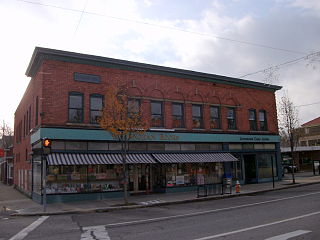
Perry Downtown Historic District is a national historic district located at Perry in Wyoming County, New York. The district encompasses 41 contributing buildings in the village of Perry. They are a variety of commercial, institutional, and governmental buildings with most built between 1850 and 1918. Most of the commercial buildings are two-stories and constructed of brick. They include the Town Hall (1909), Masonic Temple (1914), Bussey Block (1898), Bailey-Roche Block, A. Cole and Wygant Building (1867), Garrison Building (1901), Rufus Smith Block (1856), Howell Building (1895), Traver Place Apartments (1924), and the Wise Building (1903).

The Green River Downtown Historic District is a 5.7-acre (2.3 ha) historic district in Green River, Wyoming that was listed on the National Register of Historic Places in 2009. The district included 11 contributing buildings and one other contributing structure.

Lawrence's Downtown Historic District comprises the commercial core of Lawrence, Kansas. The district comprises areas along Massachusetts Street between 6th Street and South Park Street. Nearly all of the contributing structures are masonry commercial buildings, typically with display windows at street level and smaller windows at upper levels. Four properties are individually listed on the National Register of Historic Places: Old Lawrence City Hall, the old Douglas County Courthouse, the Eldridge House Hotel, and the US Post Office-Lawrence. The district includes a total of 136 resources, 99 of which are considered to contribute to the district.

The Sayre Downtown Historic District is a commercial historic district located in downtown Sayre, Oklahoma. The district comprises a three-block area of Main and 4th Streets; it includes 39 buildings, of which 24 are contributing buildings. The oldest buildings in the district date from between 1903 and 1909, when a building boom replaced Sayre's frame downtown buildings with brick Commercial style structures. By the 1920s, the downtown area had reached its current size, and most of the buildings in the district had been built. In the 1920s, U.S. Route 66 was routed through the district, increasing traffic for local businesses. Sayre's Classical Revival post office, a contributing property, was constructed in 1938; the post office includes a Works Progress Administration mural painted in 1940. The downtown remained prosperous until the 1950s, when population decline and the bypassing of Route 66 led to a decrease in commercial activity.

The West Liberty Commercial Historic District in West Liberty, Iowa, United States, is a historic district that was listed on the National Register of Historic Places in 2002. At that time, it included 41 contributing buildings, six other contributing structures, and eight non-contributing buildings.

Plymouth Downtown Historic District is a national historic district located in Plymouth, Marshall County, Indiana, United States. The district encompasses 47 contributing buildings and one contributing structure in the central business district of Plymouth. It developed between about 1870 and 1940, and includes examples of Italianate, Romanesque Revival, and Colonial Revival style architecture. Located in the district is the separately listed Plymouth Fire Station. Other notable buildings include the Montgomery Ward Building (1929), Metsker Block, Rentschler Building (1910), Early Plymouth Post Office (1884), First National Bank-Plymouth City Hall, Packard Bank Block (1879), Simons Building (1895), Wheeler Block, Bank Block, Bank Block-Masonic Temple (1901), Plymouth Post Office (1935), and Plymouth Motor Sales (1929).

The Laramie Downtown Historic District comprises the historic core of Laramie, Wyoming. Established in 1868, Laramie owes its existence to the Union Pacific Railway, which chose the site and began selling property. By 1871 Laramie was the county seat of Albany County. The historic district includes many buildings dating to the earliest days of Laramie as well as railroad-related structures built between 1870 and 1938. 59 buildings are considered to be contributing structures in the 10-1/2 square block area.

The Parco Historic District, also known as the Sinclair Historic District, comprises the center of Sinclair, Wyoming, originally known as Parco, surrounding the Parco Inn. The district includes 93 buildings, of which 49 are considered to be contributing structures to the district. Sinclair was built as a company town in 1924-25 with a consistent design theme by architects Fisher & Fisher in the Spanish Colonial revival style. In addition to the Parco Inn other significant structures include the Sinclair Theatre and Recreation Hall, the school, the library and the Community Church. The central plaza, business district and original worker housing also contribute.

The Rawlins Residential Historic District abuts the north and east sides of the commercial district of Rawlins, Wyoming. The area covers 15 blocks of small houses built between 1880 and 1915 in a variety of styles. The area was part of Union Pacific Railway property that was incorporated into Rawlins. One defining feature of the houses is a consistent use of locally quarried stone in foundations and landscape walls. Apart from the houses, St. Joseph's Catholic Church is also within the district. Styles include Queen Anne, cottage and bungalow style architecture.

The Lander Downtown Historic District comprises the commercial core of Lander, Wyoming. The district includes 16 buildings listed as contributing to the historic district, including a series of commercial buildings, the Noble Hotel, the grand Theatre and the Stockgrower's Bar. The Federal Building is included, and is individually listed on the National Register of Historic Places as well. Most date between 1890 and 1910. Most earlier buildings burned or were torn down and replaced by more permanent masonry structures.By 1910 an oil boom had begun in central Wyoming, providing an incentive to build substantial buildings. The district comprises most of the north side of Main Street between Second Street and Fourth Street, with three properties on the south side and one facing Lincoln Street at Third Street.

The Cedar Rapids Central Business District Commercial Historic District is a nationally recognized historic district located in Cedar Rapids, Iowa, United States. It was listed on the National Register of Historic Places in 2015. At the time of its nomination it consisted of 60 resources, which included 46 contributing buildings, one contributing structure, 12 non-contributing buildings, and one non-contributing structure. Cedar Rapids was platted on the east bank of the Cedar River as Rapids City in 1841, and it was incorporated under the same name in 1849. Kingston was established on the west bank of the river in 1852. The two smaller communities consolidated in 1870 as Cedar Rapids. The streets were laid out parallel and perpendicular to the river, which flowed from the northwest to the southeast. The Chicago, Iowa and Nebraska Railroad was the first to arrive in the community in 1859 and the tracks were laid on Fourth Street on the eastern edge of the central business district. The first bridge across the river was built at Third Avenue in 1871.

